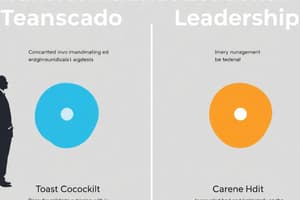Podcast
Questions and Answers
Which leadership style involves the leader making all decisions without input from team members?
Which leadership style involves the leader making all decisions without input from team members?
- Servant
- Democratic (correct)
- Transformational
- Transactional
What is the primary focus of transactional leadership?
What is the primary focus of transactional leadership?
- Aligning personal goals with the vision
- Empowering team members
- Rewarding team members for specific tasks (correct)
- Setting a clear and inspiring vision
Which aspect is a crucial component of transformational leadership?
Which aspect is a crucial component of transformational leadership?
- Focusing on specific tasks and rewards
- Prioritizing the needs of team members
- Inspiring and motivating team members to achieve a shared vision (correct)
- Making all decisions without input from team members
What distinguishes democratic leadership from autocratic leadership?
What distinguishes democratic leadership from autocratic leadership?
In which leadership style does the leader prioritize the needs of team members and empower them to achieve their goals?
In which leadership style does the leader prioritize the needs of team members and empower them to achieve their goals?
Which essential aspect of team leadership involves encouraging team members to work together and share their ideas?
Which essential aspect of team leadership involves encouraging team members to work together and share their ideas?
What is the primary focus of emotional intelligence in leadership?
What is the primary focus of emotional intelligence in leadership?
In the context of leadership communication, what does 'active listening' involve?
In the context of leadership communication, what does 'active listening' involve?
Which style of leadership involves the leader making all decisions without input from team members?
Which style of leadership involves the leader making all decisions without input from team members?
What is a crucial component of transformational leadership?
What is a crucial component of transformational leadership?
What is the practice of leading a group of people to achieve a common goal?
What is the practice of leading a group of people to achieve a common goal?
Which aspect of effective communication involves paying full attention to and understanding the speaker's message?
Which aspect of effective communication involves paying full attention to and understanding the speaker's message?
What does emotional intelligence allow leaders to do for their team members?
What does emotional intelligence allow leaders to do for their team members?
What is an important aspect of leadership that helps leaders make better decisions?
What is an important aspect of leadership that helps leaders make better decisions?
Flashcards are hidden until you start studying
Study Notes
Leadership
Leadership is the practice of leading a group of people or an organization, typically with the goal of achieving a common objective. It involves setting a vision, guiding others to achieve it, and creating an environment that fosters success. Leadership styles, transformational leadership, team leadership, leadership communication, and emotional intelligence are all crucial aspects of effective leadership.
Leadership Styles
There are various leadership styles, including:
- Autocratic: The leader makes all decisions without input from team members.
- Democratic: The leader encourages input from team members before making decisions.
- Transformational: The leader inspires and motivates team members to achieve a shared vision.
- Transactional: The leader focuses on specific tasks and rewards team members for completing them.
- Servant: The leader prioritizes the needs of team members and empowers them to achieve their goals.
Transformational Leadership
Transformational leadership is a style that focuses on inspiring and motivating team members to achieve a shared vision. It involves:
- Vision: The leader sets a clear and inspiring vision for the team to work towards.
- Inspiration: The leader inspires and motivates team members, often by aligning their personal goals with the vision.
- Value-Based: The leader leads by example, embodying the values and behaviors they want to see in their team members.
- Relationships: The leader builds strong relationships with team members, fostering trust and collaboration.
Team Leadership
Team leadership is the practice of leading a group of people to achieve a common goal. It involves:
- Collaboration: Encouraging team members to work together and share their ideas.
- Communication: Ensuring clear and open communication among team members.
- Motivation: Inspiring and motivating team members to achieve their goals.
- Accountability: Holding team members accountable for their actions and contributions.
Leadership Communication
Effective communication is crucial for successful leadership. It involves:
- Active Listening: Paying full attention to and understanding the speaker's message.
- Clear and Concise: Being clear and concise in delivering messages to avoid confusion.
- Empathy: Understanding and sharing the feelings of others.
- Feedback: Providing timely and constructive feedback to team members.
Emotional Intelligence in Leadership
Emotional intelligence is the ability to recognize, understand, and manage one's own emotions and the emotions of others. It is an important aspect of leadership, as it helps leaders:
- Build Strong Relationships: Emotional intelligence allows leaders to build strong relationships with team members, fostering trust and collaboration.
- Make Better Decisions: Leaders with high emotional intelligence are better equipped to make decisions that take into account the emotional needs and desires of their team members.
- Motivate and Inspire: Emotional intelligence helps leaders motivate and inspire their team members, leading to increased productivity and success.
In conclusion, leadership is a complex and multifaceted practice that involves various styles, communication, emotional intelligence, and teamwork. By understanding and implementing these essential aspects, leaders can create a positive and productive work environment that fosters success.
Studying That Suits You
Use AI to generate personalized quizzes and flashcards to suit your learning preferences.



